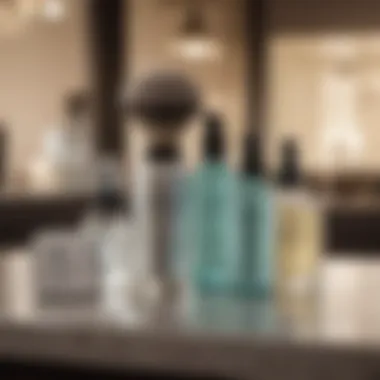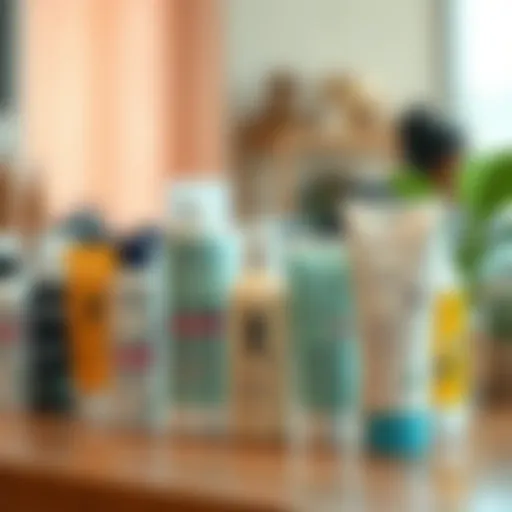Choosing the Right Razor to Avoid Ingrown Hairs


Intro
When it comes to shaving, the selection of the right razor can mean the difference between a smooth finish and a frustrating battle with ingrown hairs. These pesky occurrences happen when hair strands grow back into the skin instead of rising above it, leading to irritation, redness, and sometimes even infection. Understanding the basics surrounding razors, hair growth, and skin care is crucial, especially for those aiming to maintain healthy skin while removing unwanted hair.
This guide is tailored for women of all ages, focusing on the important features to look for in a razor that will help in preventing ingrown hairs. We’ll explore different shaving techniques, specific skin care routines designed for various skin types, and the role of aftercare in ensuring a smooth process post-shave. Additionally, you’ll gain insight into sustainable practices and how they relate to grooming. Let’s dive deeper to enhance your awareness and understanding of this often-overlooked aspect of personal care.
Tips and How-Tos
To navigate the world of razors and achieve optimal results, it’s vital to implement proper skincare routines alongside a mindful approach to shaving. Here are some pointers to help guide you along the way:
Skincare Routines for Different Skin Types
- Oily Skin: For those with oily skin, incorporating a gentle exfoliating scrub can help remove dead skin cells that can trap hair. Opt for a lightweight moisturizer that won't clog pores. Avoid heavy creams before shaving to minimize slip and keep hair upright.
- Dry Skin: If your skin tends to be on the dryer side, consider using a hydrating pre-shave oil. It can soften the hair and give your razor a smoother glide. Look for formulations that contain natural oils like coconut or jojoba oil.
- Sensitive Skin: Choose hypoallergenic products without strong fragrances. A soothing post-shave balm formulated with aloe or chamomile can calm irritation. Avoid shaving against the grain, as this increases the risk of ingrown hairs.
Essential Shaving Techniques
- Use the Right Razor: A multi-blade razor might seem appealing, but for some, a single-blade safety razor can minimize skin irritation. The fewer blades, the less chance of causing hair to grow back into your skin.
- Shaving Cream: Apply a good quality shaving cream or gel. It acts as a barrier, providing protection between the skin and the razor. Choose products with natural, moisturizing ingredients to prevent dryness.
- Shaving Direction: Always shave in the direction of hair growth, also known as shaving with the grain. This simple practice can significantly reduce the chances of hair becoming ingrown.
"The most important aspect of shaving is understanding your skin and hair type; what works for one person may not be suitable for another."
- Rinsing the Razor: Continuously rinse your razor under warm water during shaving. It prevents buildup of hair and cream which can result in a rough shave.
- Post-Shave Care: Once you're done, pat your skin dry with a soft towel. Avoid rubbing as this can cause irritation. Apply a light, fragrance-free moisturizer to replenish hydration.
Sustainable Practices
Adopting eco-friendly strategies in your grooming routine isn't just beneficial for the environment but can also enhance your personal care routine. Here are some ways to make your grooming more sustainable:
- Switch to a Safety Razor: They are not only better for the planet but also economical in the long run. Replaceable blades minimize waste.
- Choose Bulk Products: When possible, select skincare products sold in bulk to reduce packaging waste. This applies to creams, lotions, and even shaving gels
- Eco-Friendly Brands: Look for brands that prioritize sustainability. Products that come in biodegradable packaging or use organically sourced ingredients are great options.
Tips for Sustainable Grooming
- Opt for organic shaving gels and creams that are free from harsh chemicals.
- Reuse towel scraps as shaving wipes to further cut down on waste.
- Look for refillable personal care options to reduce plastic consumption.
By embracing these sustainable practices, you contribute positively to not only your own skin health but the planet as a whole. It’s a win-win!
Celebrating Diversity in Beauty
The world of beauty is rich and diverse, making it crucial to recognize the range of grooming needs based on various backgrounds and skin types. Here’s how this can be embraced in grooming routines:
Inclusive Beauty Brands
Many beauty brands now focus on inclusivity, catering to a wide array of skin tones and hair types. It's essential to support brands that prioritize diversity and offer tailored products for different needs. Brands like Fenty Beauty and SheaMoisture demonstrate that beauty is not one-size-fits-all by creating products that celebrate varied skin and hair characteristics.
Cultural Influences on Fashion
Cultural beauty practices can offer insights into effective grooming techniques. For instance, the use of natural oils in beauty routines can be traced back to various cultures around the world, showcasing the versatility of ingredients derived from local practices. Learning and embracing these techniques can enhance personal care and highlight the beauty in diversity.
By understanding each of these factors — from choosing the right razor to caring for your skin — you're empowered to tackle the challenge of ingrown hairs head-on, ensuring a smoother and more comfortable shaving experience.
Anatomy of Ingrown Hairs
Understanding ingrown hairs is vital for anyone facing the often vexing issue of maintaining smooth skin. These pesky hairs can lead to discomfort and irritation, so grasping the mechanics behind their formation is necessary for prevention. The anatomy of ingrown hairs consists of several components, including the hair follicle, the hair growth cycle, and skin's response to hair that curls back into the skin. By dissecting these elements, individuals can make better choices when selecting razors or shaving techniques.
Understanding Ingrown Hair Formation
Ingrown hairs occur when hair grows sideways or curls back into the skin instead of emerging from the follicle. This can lead to inflammation or infection, often visible as red bumps or pustules. It’s a common issue, especially among people with coarse or curly hair. As hair follicles push through the skin, they can become blocked by dead skin cells, oil, or product buildup, exacerbating the problem. Knowing the stages of this formation can help in addressing the issue effectively.
- Initial Growth: The hair begins to grow out of the follicle.
- Blockage: Buildup can occur around the follicle, preventing the hair from emerging.
- Curling: The hair starts to curve back towards the skin, causing irritation.
By understanding these phases, one can adopt strategies to prevent hair from becoming ingrown.
Common Areas for Ingrown Hairs
Ingrown hairs tend to pop up in certain areas more than others. In particular, individuals should be mindful of the following zones:


- Face: Particularly around the chin and neck, where people frequently shave.
- Armpits: Curly hair is more prone to ingrowing in this sensitive area.
- Bikini Line: A common trouble spot, particularly for women who maintain hair removal in that region.
- Legs: Many women experience ingrown hairs on the thighs as well as calves due to shaving.
Awareness of these hotspots can guide the shaving routine, helping individuals target care where it’s most needed.
Factors Contributing to Ingrown Hairs
Several elements can heighten the chances of experiencing ingrown hairs. It’s important to take note of these factors to choose the right razor and shaving technique:
- Hair Texture: Curly or coarse hair types are more susceptible to becoming ingrown.
- Improper Shaving Technique: Shaving against the grain without proper technique can irritate the hair, compelling it to grow inward.
- Skin Condition: Dry or dead skin can clog follicles, leading to ingrown hairs.
- Razor Quality: Using a dull or improperly designed razor can also increase the likelihood of ingrowth.
"Prevention begins with proper awareness of both the physical factors and the personal techniques applied during shaving."
Grasping the nuances behind ingrown hairs not only assists in diagnosis but also arms individuals with the knowledge required to choose an optimal razor, thus paving the path toward smoother skin.
The Role of Razors in Preventing Ingrown Hairs
Choosing the right razor plays a pivotal role in minimizing the occurrence of ingrown hairs, which can cause irritation and discomfort. A suitable razor not only removes hair effectively but also helps maintain skin health, reducing the chances of hair growing back into the skin. The method of hair removal can either exacerbate or ease the situation.
In many cases, individuals face a dilemma about what type of razor to use. It’s not a matter of picking random brands; rather it’s about understanding characteristics that contribute to a smoother and safer shaving experience.
Taking time to explore the benefits and potential drawbacks of different razors can lead to wiser decisions. When armed with the right knowledge, users can effectively achieve a more pleasant grooming routine.
Types of Razors Overview
There are various types of razors designed specifically to cater to different skin types and hair textures. Each has unique traits that contribute to either hair removal efficiency or skin comfort. Here are the main types:
- Cartridge Razors: These are often favored for their convenience and ease of use. They typically come with multiple blades and are designed for a close shave with minimal effort.
- Safety Razors: Built to offer better control, these razors have a single, sharp blade that can reduce the chances of nicks or cuts when used properly.
- Electric Razors: The electric version comes with its own set of benefits, providing a quick shaving solution without the need for shaving creams or gels.
Each type presents its own merits, which can very well align with an individual's shaving needs and preferences.
Safety Razors vs. Cartridge Razors
When weighing safety razors against cartridge razors, consider the following:
- Safety Razors:
- Cartridge Razors:
- Generally provide a closer shave since they use a single blade.
- Less likely to cause ingrown hairs because they cut hair at skin level.
- Tend to be more sustainable as they only require changing out the blade instead of the entire razor.
- Easy to find and often come with features like moisturizing strips.
- Offer a quick solution ideal for those new to shaving or in a rush.
- Depending on the number of blades, they can sometimes lead to irritation since multiple blades can tug at the hair, which is not always ideal for sensitive skin.
By analyzing these features, one can make a more informed choice suited to their needs and another step towards avoiding ingrown hairs.
Electric Razors: Pros and Cons
Electric razors are quite popular for their practicality and speed but they present both advantages and disadvantages.
Pros:
- Speed: They allow for a quick shave without the hassle of traditional methods.
- Convenience: Most electric razors can be used without water or shaving cream, which can be a game-changer in busy mornings.
- Less Nicking: They may reduce the risk of cuts due to lack of direct blade contact with the skin.
Cons:
- Hair Length: They are often less effective with very coarse or overly curly hair, giving less close shave.
- Skin Sensitivity: For some users, they can irritate the skin more than traditional razors, depending on individual skin types.
- Maintenance: Regular cleaning and upkeep are necessary to keep them functioning well.
Overall, selecting the right razor is paramount in preventing ingrown hairs. Knowing the differences between the razor types available can significantly enhance your shaving routine, helping to avoid unwanted skin issues down the road.
Features to Look for in an Anti-Ingrown Hair Razor
Choosing the right razor is crucial in the quest to prevent ingrown hairs. Certain features can make a significant difference in the shaving experience, ensuring not only a smooth finish but also minimizing the risk of hair growing back beneath the skin. A well-designed razor can serve as your first line of defense against irritation and discomfort often associated with ingrown hairs. Here, we'll explore the essential features that should be on your radar while selecting the ideal razor for your needs.
Blade Configuration and Design
When it comes to razors, the blade configuration can play a pivotal role in how well a shave goes. Ideally, look for razors that incorporate a staggered blade design. This allows the hairs to be cut at a slightly different angle, which reduces the likelihood of hair being pushed back into the follicle.


A good razor will also have multiple blades, often ranging between three and five. However, it’s not just about the number of blades but how they are arranged. Blades that are spaced appropriately can help to lift the hairs before they’re cut, providing a closer shave with less chance of irritation.
- Single-Blade Option: Some people might prefer safety razors with a single blade. These razors reduce the pushing effect that multi-blade types can exert, which can lower the risk of ingrown hairs.
- Curved or Flexible Heads: A head that pivots will follow the contour of your skin more closely, meaning that you can get a closer shave without pressing too hard.
Handle Comfort and Grip
The ergonomics of the razor's handle can't be overlooked. Comfort and grip are essential for executing a clean shave. A handle that fits naturally in your hand can make a world of difference, allowing you to maintain control even in tricky areas where ingrown hairs commonly occur. Look for:
- Non-slip Materials: These can prevent the razor from slipping out of your hand, especially in wet conditions.
- Well-shaped Handles: Handles with contours allow for a more natural grip and reduce the strain on your wrist.
Ultimately, being able to maneuver the razor easily will allow you to shave with more precision, leading to fewer nicks and scratches that can irritate the skin.
Blade Quality: Disposable vs. Reusable
Another pivotal feature to consider is the quality of the blade, along with whether it’s disposable or reusable. While disposable blades might feel like a more convenient option, they can sometimes sacrifice quality for cost. A blade that’s too dull can tug at hairs instead of cutting them cleanly, which is a recipe for ingrown hairs.
- Disposable Blades: If you're often on the go, a good quality disposable with sharp blades can work decently. Opt for brands that prioritize quality in their manufacturing.
- Reusable Blades: Investing in a quality reusable razor often pays off long-term. Reusable ones typically come with superior blades and can be replaced when they dull, allowing for a consistent shave over time.
Recommended Razors for Reducing Ingrown Hairs
Choosing the right razor is pivotal to minimizing the occurrence of ingrown hairs. The razor you use is not just a tool; it can have a profound impact on the health of your skin and the effectiveness of your shaving routine. Let’s uncover the elements that make a razor stand out in the battle against this annoying issue.
Opting for a razor tailored to your needs can mean the difference between smooth skin and the discomfort of ingrown hairs. Factors like razor type, blade design, and user comfort can significantly influence your shaving experience and skin health.
Top Safety Razors
Safety razors are often celebrated for their classic design and effectiveness. One popular example is the Merkur 34C Heavy Duty, prized by many for its balance and ease of use. The design allows for a single blade to make intimate contact with the skin, cutting hair without pulling, which reduces irritation and the likelihood of ingrown hairs.
Using a safety razor takes a bit of practice. However, the investment can pay off with smoother skin and fewer issues over time. People appreciate that the blades can be replaced easily and that they last longer compared to disposable cartridges. Moreover, they tend to be more environmentally friendly — a win-win situation.
Best Cartridge Razors Available
Cartridge razors, though often associated with modern convenience, can also provide effective solutions for those looking to mitigate ingrown hairs. A standout choice is the Gillette Fusion5 ProGlide. Its multi-blade system is designed to glide easily over the skin, adjusting to its contours and minimizing the risk of hair getting trapped below the surface.
However, it’s critical to avoid pressing too hard, as that can lead to cuts or an overly close shave, contributing to skin irritation. Regularly replacing blades is essential to maintain cutting efficiency and comfort.
Noteworthy Electric Razors
Electric razors can be a fantastic option for those who struggle with ingrown hairs. A good choice is the Braun Series 7, which is known for its adaptability on any skin type. Its ability to adjust power based on the density of hair adds comfort and precision to the whole process.
While electric razors can prevent ingrown hairs due to their design, they're not a cure-all. It's still advisable to follow proper shaving techniques and maintain a good skincare routine amid electric shaving to further enhance results.
"A razor doesn’t just trim hair; it holds the potential for a confident appearance when chosen wisely."
Shaving Techniques to Minimize Ingrown Hairs
Shaving is more than simply dragging a blade across the skin. It's a craft that, when done right, can prevent unwelcome nuisances like ingrown hairs. These pesky little invaders can erupt in various spots, making the skin itchy and uncomfortable. Choosing the right razor is a cornerstone, but it’s the technique used that often makes the biggest difference. This section will unpack the vital steps to ensure that every shave is as smooth as possible, with a focus on preparation, technique, and aftercare.
Pre-Shave Preparation
Getting ready to shave isn’t just a matter of lathering up and going at it like a bull in a china shop. It starts with effective pre-shave preparation, which sets the stage for a smooth experience. This step is crucial for opening up the pores and softening the hair, which can significantly lower the chances of hairs curling back into the skin.
- Cleanse the Skin: Use a gentle cleanser to rid the skin of oil and dirt. This creates a clear canvas for the razor.
- Warm Water: Rinse your face with warm water or take a warm shower beforehand. The heat opens up the pores and softens hair shafts, making the shaving process easier.
- Exfoliate: Don’t skip this part! Using an exfoliating scrub a day or two before shaving removes dead skin cells and can help prevent hairs from getting trapped.
- Apply Pre-Shave Oil: A few drops of pre-shave oil can provide extra lubrication. This can ease the glide of the razor, reducing friction and irritation.
A well-thought-out preparation routine not only creates an ideal environment for shaving but also contributes significantly to the overall skin health.
Correct Shaving Techniques
Now that the skin is properly prepared, it is essential to adopt the right shaving techniques. Incorrect methods often lead to not just discomfort but a higher likelihood of ingrown hairs returning to haunt you. Here are some tips:
- Use Short, Light Strokes: Long strokes might feel efficient, but they can cause more harm than good. Short, controlled strokes allow for better maneuverability of the razor, especially around contours.
- Follow Hair Growth: Shaving against the grain may seem like a shortcut to a closer shave, but it can increase the risk of hair curling back under the skin. Instead, always shave in the direction of hair growth.
- Don’t Rush: Take your time. Hurrying through a shave often invites nicks and cuts, both of which can lead to inflammation, creating an environment ripe for ingrown hairs.
- Rinse the Blade Often: After every few strokes, rinse the blade in warm water to remove hair and product build-up. A clean blade maintains efficiency and reduces tugging on the hair.
By incorporating these techniques into your routine, you not only enhance the technique but also show your skin some much-needed respect.


Post-Shave Care Essentials
After putting the blade down, the care doesn’t just end there; in fact, it might very well be the most crucial part. The skin is vulnerable right after shaving, and if not cared for properly, it can lead to irritation, inflammation, and yes, ingrown hairs. Here are essential post-shave care practices:
- Cold Water Rinse: Follow your shave with a rinse of cool or cold water. This can help close the pores and soothe the skin, providing a refreshing feeling after the heat of shaving.
- Apply a Soothing Aftershave: Choose an alcohol-free aftershave or a soothing balm. Look for products with ingredients like aloe vera or witch hazel to calm the skin and reduce redness.
- Moisturize: Don’t let your skin go dry. Apply a light moisturizer to maintain hydration, especially if you have sensitive skin.
- Avoid Direct Sunlight: Try to keep your freshly shaved skin out of direct sunlight for a day or two to reduce the risk of irritation.
Remember, taking care of your skin post-shave is just as important as your pre-shave steps and the shaving technique itself. It all ties together to create a strategy in the battle against ingrown hairs.
In summary, effective shaving techniques extend well beyond just the act of shaving itself. They encompass a comprehensive approach that includes solid preparation, correct technique, and thoughtful aftercare. Adopting these methods will help in minimizing ingrown hairs, ensuring your skin feels nurtured and looks its best.
Skincare Routine to Combat Ingrown Hairs
A thoughtful skincare routine is crucial when aiming to combat ingrown hairs. This goes beyond just using the right razor or shaving technique; one must consider how the skin is treated before and after the shave. A solid skincare regimen can help reduce the risk of ingrown hairs significantly and contribute to overall skin health.
Exfoliation Principles
Exfoliation is like giving your skin a spring clean. By sloughing off dead skin cells, you help prevent the hair follicles from becoming blocked, which is one of the main culprits behind ingrown hairs. Scrubbing or using an exfoliating scrub at least once or twice a week can be beneficial. There are different methods to exfoliate, ranging from physical scrubs that you can use with your hands to chemical exfoliants that contain alpha-hydroxy acids. The key is to be consistent but gentle; over-exfoliating can lead to irritation, which tends to make things worse. Keeping the skin smooth goes a long way in letting hair grow freely.
"Regular exfoliation can lead to healthier skin and a significant reduction in ingrown hairs."
Moisturizing after Shaving
Moisturizing is another important part of any skincare routine, especially post-shave. Freshly shaved skin can be sensitive and prone to irritation, and applying a good moisturizer helps keep it hydrated. Look for lightweight, non-comedogenic creams that won’t clog pores. Products with ingredients like aloe vera or hyaluronic acid can offer soothing benefits while preventing dryness. A quick application of moisturizer right after shaving locks in moisture and maintains the skin barrier, making your skin feel smooth and pampered.
Avoiding Irritation Through Product Choices
Choosing the right shaving and skincare products plays a pivotal role in preventing ingrown hairs. It's essential to steer clear of heavy or greasy products that might cause build-up on the skin, leading to clogged pores. Opt for alcohol-free aftershaves, as they can cause excessive dryness and irritation. Ingredients like tea tree oil or witch hazel can be beneficial for their natural antibacterial properties. Always patch-test new products first, especially if you have sensitive skin, to avoid any unintended reactions.
In sum, a dedicated skincare routine is your skin's best friend when it comes to preventing ingrown hairs. By employing effective exfoliation, moisturizing diligently, and selecting the right products, you build a robust barrier against pesky ingrown hairs.
Additional Tips for Preventing Ingrown Hairs
Preventing ingrown hairs is not solely about selecting the right razor; it also involves a collection of smart practices that make a tangible difference. This section delves into supplemental techniques that can complement your shaving routine. Focusing on these elements can help you maintain healthier skin and a smoother shave, thus minimizing the risk of those pesky ingrown hairs.
Avoiding Too Close Shaves
While the thrill of achieving that baby-soft skin after a shave might tempt you to go as close to the skin as possible, this can often backfire. Shaving too closely can lead to sharp hair ends that easily curl back into the skin, triggering ingrown hairs. Instead, try to maintain a reasonable distance from the skin's surface. This doesn't mean you should neglect technique, but focus on a comfortable shave that still leaves the skin smooth without going for perfection.
- Use a light touch while applying the razor,
- Aim for a single pass where you can,
- Adjust the angle of your razor to a less aggressive one,
- Take your time, as rushing can lead to mistakes—be patient!
Regular Razor Maintenance
A well-maintained razor does wonders in the fight against ingrown hairs. Over time, rust or dull blades can irritate the skin and make shaving less efficient. Regularly assessing and maintaining your razor can help, and here’s how:
- Clean your razor after each use to remove any hair, product, or bacteria.
- Replace blades frequently; it’s not just about sharpness but also hygiene.
- Consider drying your razor fully to minimize rust—this small step can prolong the life of your razors and improve blood circulation of skin beneath.
Taking these few minutes can mean a world of difference, transforming a good shave into a great one.
Consulting Dermatological Guidance
Sometimes, turning to the experts can provide insights that standard guideline just doesn’t cover. For persistent skin issues or ingrown hairs that just won’t quit, consulting a dermatologist can help identify underlying causes. They can offer tailored recommendations based on individual skin types and hair textures. You might discover great tips or products that aren’t on the mainstream radar.
"Consult a dermatologist if you experience frequent ingrown hairs, as they may recommend specialized treatments or grooming techniques."
Additionally, regular skin check-ups can help anyone understand how their skin reacts to specific products, allowing for a more personalized, effective shaving routine. Don’t hesitate to take a proactive approach; your skin will thank you later.
By weaving these additional strategies into your routine, you set the stage for healthier, smoother skin, reducing ingrown hair occurrence significantly. Consider each tip not just a passing notion but as essential parts of a holistic approach to your shaving habits.
The End: Making Informed Choices
In the world of grooming, making the right razor choice might seem trivial, yet it carries significant weight in preventing the nuisance of ingrown hairs. Getting a proper razor can save individuals from discomfort and irritation, which often stems from using mismatched products. It's about more than picking a shiny, new item off the shelf; it's about harmonizing with your skin's specific requirements.
When evaluating your shaving needs, consider not just how frequently you shave, but the thickness of your hair, skin sensitivity, and past experiences. Informed decisions rest upon a foundation built from personal understanding combined with acquired knowledge. Here are some key elements to weigh:
- Your Hair Type: Different hair textures require different handling. Coarse hair might necessitate a more robust razor, whereas finer hair could be well-suited to gentler options.
- Your Skin Sensitivity: If you often encounter irritation, invest in products tailored to sensitive skin. This might mean opting for safety razors or specific cartridges designed to minimize friction.
- Personal Shaving Routine: Incorporate your shaving habits into your decision-making. Do you shave daily, or just once a week? Those who shave regularly might benefit from interchangeable blade options or models with better longevity.
- Cost Considerations: While it may be tempting to go for a cheaper option, remember that investing in a quality razor can often pay off in the long run by reducing occurrences of ingrown hairs and other skin issues.
"Quality often outweighs quantity when it comes to grooming products. A thoughtful purchase today can lead to smoother sailing tomorrow."
By synthesizing the information presented throughout this article, readers can avoid the blunders that many face in their shaving journeys. Instead of being ensnared by marketing ploys, you’re empowered to identify what truly meets your needs. Achieving a seamless shave is not a matter of luck; it’s about making informed decisions tailored to your unique circumstance. With the right knowledge, achieving your best shave can become not just possible, but inevitable.







